Sap Flow Density of the Prevailing Tree Species in a Hemiboreal Forest under Contrasting Meteorological and Growing Conditions
Abstract
:1. Introduction
- To determine the sap flow density rates of the dominant tree species under different growing conditions;
- To clarify the effects of extreme meteorological factors on the sap flow density rate of the dominant tree species in forest sites with different hydrological regimes;
- To detect the responses of the sap flow density of the considered tree species to drought at different forest sites;
- Based on the obtained results, to assess the species-specific ability of the considered tree species to adapt to changing meteorological conditions under different growing conditions.
2. Material and Methods
2.1. Study Site
2.2. The Parameters of the Monitored Trees
2.3. Tree Sap Flow Density
2.4. Meteorology
2.5. Statistical Analysis
3. Results
3.1. Meteorological Conditions in the Northeastern Part of Lithuania in the 2016–2019 Period
3.2. Meteorological Extremes in 2019
- I:
- Beginning of the season, DOY 82–135—from the beginning of continuous sap flow until the soil temperature reached 9 °C, when the leaf spread of birch trees reached 80%.
- II:
- before drought, DOY 136–173—from the end of the first period until the drought.
- III:
- drought, DOY 174–185—when the soil water content at the Nb FS was below 4% and the soil water potential was <120 kPa.
- IV:
- after drought, DOY 186–260—from the end of the drought until the end of heavy vegetation and the beginning of the leaf yellowing of birch trees.
3.3. Sap Flow and Its Seasonal Variation at Forest Sites with Different Hydrological Regimes
3.4. Sap Flow Density of the Considered Tree Species during Contrasting Seasons
3.5. Effect of the Meteorology on the Sap Flow Qs of the Monitored Trees during the Dry 2019 Season
3.6. Vapor Pressure Deficit (VPD)—A Key Factor for Sap Flow Qs Intensity
3.7. Effect of Soil Temperature on the Sap Flow (Qs) of the Considered Tree Species
4. Discussion
5. Conclusions
Author Contributions
Funding
Data Availability Statement
Acknowledgments
Conflicts of Interest
References
- Solberg, S. Summer drought: A driver for crown condition and mortality of Norway spruce in Norway. For. Pathol. 2004, 34, 93–104. [Google Scholar] [CrossRef]
- Allen, C.D.; Macalady, A.K.; Chenchouni, H.; Bachelet, D.; McDowell, N.; Vennetier, M.; Kitzberger, T.; Rigling, A.; Breshears, D.D.; Hogg, E.H.; et al. A global overview of drought and heat-induced tree mortality reveals emerging climate change risks for forests. For. Ecol. Manag. 2010, 259, 660–684. [Google Scholar] [CrossRef]
- Allen, C.; Breshears, D.; McDowell, N. On underestimation of global vulnerability to tree mortality and forest die-off from hotter drought in the Anthropocene. Ecosphere 2015, 6, 1–55. [Google Scholar] [CrossRef]
- Eilmann, B.; Rigling, A. Tree-growth analyses to estimate tree species drought tolerance. Tree Physiol. 2012, 32, 178–187. [Google Scholar] [CrossRef] [PubMed]
- Augustaitis, A.; Augustaitienė, I.; Kliučius, A.; Pivoras, G.; Šopauskienė, D.; Girgždienė, R. The seasonal variability of air pollution effects on pine conditions under changing climates. Eur. J. For. Res. 2010, 129, 431–441. [Google Scholar] [CrossRef]
- Augustaitis, A.; Augustaitienė, I.; Mozgeris, G.; Juknys, R.; Vitas, A.; Jasinevičienė, D. Growth patterns of Scots pine (Pinus sylvestris L.) under the current regional pollution load in Lithuania. iForest 2015, 8, 509–516. [Google Scholar] [CrossRef]
- Augustaitis, A.; Augustaitienė, I.; Baumgarten, M.; Bičenkienė, S.; Girgždienė, R.; Kulbokas, G.; Linkevičius, E.; Marozas, V.; Mikalajūnas, M.; Mordas, G.; et al. Tree-ring formation as an indicator of forest capacity to adapt to the main threats of environmental changes in Lithuania. Sci. Total Environ. 2018, 615, 1247–1261. [Google Scholar] [CrossRef] [PubMed]
- Spiecker, H. Growth dynamics in a changing environment long-term observation. Plant Soil 1995, 169, 555–561. [Google Scholar] [CrossRef]
- Solberg, S.; Dobbertin, M.; Reinds, G.J.; Lange, H.; Andreassen, K.; Fernandez, P.G.; Hildingsson, A.; de Vries, V. Analyses of the impact of changes in atmospheric deposition and climate on forest growth in European monitoring plots: A stand growth approach. For. Ecol. Manag. 2009, 258, 1735–1750. [Google Scholar] [CrossRef]
- Reyer, C.P.O.; Brouwers, N.; Rammig, A.; Brook, B.W.; Epila, J.; Grant, R.F.; Holmgren, M.; Langerwisch, F.; Leuzinger, S.; Lucht, W.; et al. Forest resilience and tipping points at different spatio-temporal scales: Approaches and challenges. J. Ecol. 2015, 103, 5–15. [Google Scholar] [CrossRef]
- Vanoni, M.; Bugmann, H.; Nötzli, M.; Bigler, C. Quantifying the effects of drought on abrupt growth decreases of major tree species in Switzerland. Ecol. Evol. 2016, 6, 3555–3570. [Google Scholar] [CrossRef] [PubMed]
- Hartmann, H.; Moura, C.F.; Anderegg, W.R.L.; Ruehr, N.K.; Salmon, Y.; Allen, C.D.; Galbraith, D. Research frontiers for improving our understanding of drought-induced tree and forest mortality. New Phytol. 2018, 218, 15–28. [Google Scholar] [CrossRef] [PubMed]
- Zhao, X.; Li, X.; Hu, W.; Liu, J.; Di, N.; Duan, J.; Li, D.; Liu, Y.; Guo, Y.; Wang, A.; et al. Long-term variation of the sap flow to tree diameter relation in a temperate poplar forest. J. Hydrol. 2023, 618, 129189. [Google Scholar] [CrossRef]
- Di, N.; Xi, B.; Clothier, B.; Wang, Y.; Li, G.; Jia, L. Diurnal and nocturnal transpiration behaviors and their responses to groundwater-table fluctuations and meteorological factors of Populus tomentosa in the North China Plain. For. Ecol. Manag. 2019, 448, 445–446. [Google Scholar] [CrossRef]
- Liu, J.; Li, D.; Ferńandez, J.E.; Coleman, M.; Hu, W.; Di, N.; Zou, S.; Liu, Y.; Xi, B.; Clothier, B. Variations in water-balance components and carbon stocks in poplar plantations with differing water inputs over a whole rotation: Implications for sustainable forest management under climate change. Agric. For. Meteorol. 2022, 320, 108958. [Google Scholar] [CrossRef]
- Landsberg, J.; Waring, R. Water relations in tree physiology: Where to from here? Tree Physiol. 2017, 37, 18–32. [Google Scholar] [CrossRef] [PubMed]
- Dragoni, D.; Lakso, A.N.; Piccioni, R.M. Transpiration of apple trees in a humid climate using heat pulse sap flow gauges calibrated with whole-canopy gas exchange chambers. Agric. For. Meteorol. 2005, 130, 85–94. [Google Scholar] [CrossRef]
- Kume, T.; Komatsu, H.; Kuraji, K.; Suzuki, M. Less than 20-min time lags between transpiration and stem sap flow in emergent trees in a Bornean tropical rainforest. Agric. For. Meteorol. 2008, 148, 1181–1189. [Google Scholar] [CrossRef]
- Tie, Q.; Hu, H.; Tian, F.; Guan, H.; Lin, H. Environmental and physiological controls on sap flow in a subhumid mountainous catchment in North China. Agric. For. Meteorol. 2017, 240–241, 46–57. [Google Scholar] [CrossRef]
- Chang, X.; Zhao, W.; He, Z. Radial pattern of sap flow and response to microclimate and soil moisture in Qinghai spruce (Picea crassifolia) in the upper Heihe River Basin of arid northwestern China. Agric. For. Meteorol. 2014, 187, 14–21. [Google Scholar] [CrossRef]
- Mitchell, P.J.; Veneklaas, E.; Lambers, H.; Burgess, S.S.O. Partitioning of evapotranspiration in a semi-arid eucalypt woodland in south-western Australia. Agric. For. Meteorol. 2009, 149, 25–37. [Google Scholar] [CrossRef]
- Poyatos, R.; Granda, V.; Molowny-Horas, R.; Mencuccini, M.; Steppe, K.; Martínez-Vilalta, J. SAPFLUXNET: Towards a global database of sap flow measurements. Tree Physiol. 2016, 36, 449–1455. [Google Scholar] [CrossRef] [PubMed]
- Hartmann, H.; Bastos, A.; Das, A.J.; Esquivel-muelbert, A.; Hammond, W.M.; Martínez-vilalta, J.; Mcdowell, N.G.; Powers, J.S.; Pugh, T.A.M.; Ruthrof, K.X.; et al. Climate change risks to global forest health: Emergence of unexpected events of elevated tree mortality worldwide. Annu. Rev. Plant Biol. 2022, 73, 673–702. [Google Scholar] [CrossRef]
- Anderegg, W.R.L.; Anderegg, L.D.L.; Huang, C.-Y. Testing early warning metrics for drought-induced tree physiological stress and mortality. Glob. Chang. Biol. 2019, 25, 2459–2469. [Google Scholar] [CrossRef]
- UN-ECE. Manual on Methods and Criteria for Harmonized Sampling Assessment, Monitoring and Analyses on Air Pollution on Forests; ICP: New York, NY, USA, 1994; p. 178. [Google Scholar]
- Augustaitis, A. Impact of Meteorological Parameters on Responses of Pine Crown Condition to Acid Deposition at Aukstaitija National Park. Balt. For. 2011, 17, 205–214. [Google Scholar]
- Mikalajūnas, M.; Pretzsch, H.; Mozgeris, G.; Linkevičius, E.; Augustaitienė, I.; Augustaitis, A. Scots pine’s capacity to adapt to climate change in hemi-boreal forests in relation to dominating tree increment and site condition. iForest 2021, 14, 473–482. [Google Scholar] [CrossRef]
- Kraft, G. Beiträge zur Lehre von den Durchforstungen, Schlagstellungen und Lichtungshieben; Klindworth‘s Verlag: Hannover, Germany, 1884. [Google Scholar]
- Flo, V.; Martinez-Vilalta, J.; Steppe, K.; Schuldt, B.; Poyatos, R. A synthesis of bias and uncertainty in sap flow methods. Agric. For. Meteorol. 2019, 271, 362–374. [Google Scholar] [CrossRef]
- Komatsu, H.; Shinohara, Y.; Nogata, M.; Tsuruta, K.; Otsuki, K. Changes in canopy transpiration due to thinning of a Cryptomeria japonica plantation. Hydrol. Res. Lett. 2013, 7, 60–65. [Google Scholar] [CrossRef]
- Burgess, S.S.O.; Adams, M.A.; Turner, N.C.; Beverly, C.R.; Ong, C.K.; Khan, A.A.H.; Bleby, T.M. An improved heat pulse method to measure low and reverse rates of sap flow in woody plants. Tree Physiol. 2001, 21, 589–598. [Google Scholar] [CrossRef] [PubMed]
- ICT International. Sap Flow Tool. Analysis and Visualization of Sap Flow Data. User Manual. 2016. Version 1.4. Available online: https://ictinternational.com/manuals-and-brochures/sfm1x-sap-flow-meter/ (accessed on 24 June 2024).
- Baumgarten, M.; Weis, W.; Kühn, A.; May, M.; Matyssek, R. Forest transpiration targeted through xylem sap flux assessment versus hydrological modeling. Eur. J. For. Res. 2014, 133, 677–690. [Google Scholar] [CrossRef]
- Baumgarten, M.; Hesse, B.D.; Augustaitienė, I.; Marozas, V.; Mozgeris, G.; Byčenkienė, S.; Mordas, G.; Pivoras, A.; Pivoras, G.; Juonytė, D.; et al. Responses of species-specific sap flux, transpiration and water use efficiency of pine, spruce and birch trees to temporarily moderate dry periods in mixed forests at a dry and wet forest site in the hemi-boreal zone. J. Agric. Meteorol. 2019, 75, 13–29. [Google Scholar] [CrossRef]
- Edwards, W.R.N.; Becker, P.; Čermák, J. A unified nomenclature for sap flow measurements. Tree Physiol. 1997, 17, 65–67. [Google Scholar] [CrossRef]
- LHMT (Lithuanian Hydrometeoservice). 2020. Available online: https://www.meteo.lt/ (accessed on 12 January 2021).
- Liu, Z.; Yu, S.; Xu, L.; Wang, Y.; Yu, P.; Chao, Y. Differentiated responses of daytime and nighttime sap flow to soil water deficit in a larch plantation in Northwest China. Agric. Water Manag. 2023, 289, 108540. [Google Scholar] [CrossRef]
- Oogathoo, S.; Houle, D.; Duchesne, L.; Kneeshaw, D. Vapor pressure deficit and solar radiation are the major drivers of transpiration of balsam fir and black spruce tree species in humid boreal regions, even during a short-term drought. Agric. For. Meteorol. 2020, 291, 108063. [Google Scholar] [CrossRef]
- United Nations. Sustainable Development Goals: 17 Goals to Transform Our World. 2015. Available online: http://www.un.org/sustainabledevelopment/sustainable-development-goals/ (accessed on 15 June 2020).
- Bréda, N.; Huc, R.; Granier, A.; Dreyer, E. Temperate forest trees and stands under severe drought: A review of ecophysiological responses, adaptation processes and long-term consequences. Ann. For. Sci. 2006, 63, 625–644. [Google Scholar] [CrossRef]
- Grossiord, C.; Buckley, T.N.; Cernusak, L.A.; Novick, K.A.; Poulter, B.; Siegwolf, R.T.W.; Sperry, J.S.; McDowell, N.G. Plant responses to rising vapor pressure deficit. New Phytol. 2020, 226, 1550–1566. [Google Scholar] [CrossRef] [PubMed]
- Boczoń, A.; Wróbel, M. The influence of drought on the water uptake by Scots pines (Pinus sylvestris L.) at different positions in the tree stand. For. Res. Pap. 2015, 76, 370–376. [Google Scholar] [CrossRef]
- Ozolinčius, R.; Lekevičius, E.; Stakėnas, V.; Galvonaitė, A.; Samas, A.; Valiukas, D. Lithuanian forests and climate change: Possible effects on tree species composition. Eur. J. For. Res. 2014, 133, 51–60. [Google Scholar] [CrossRef]
- Sykes, M.T.; Prentice, I.C.; Cramer, W.A. Bioclimatic Model for the Potential Distributions of North European Tree Species Under Present and Future Climates. J. Biogeogr. 1996, 23, 203–233. Available online: https://researchers.mq.edu.au/en/publications/a-bioclimatic-model-for-the-potential-distributions-of-north-euro (accessed on 2 January 2024). [CrossRef]
- Hanewinkel, M.; Cullmann, D.A.; Schelhaas, M.J.; Nabuurs, G.J.; Zimmermann, N.E. Climate change may cause severe loss in the economic value of European forest land. Nat. Clim. Chang. 2013, 3, 203–207. [Google Scholar] [CrossRef]
- Zimmermann, N.E.; Normand, S.; Pearman, P.B.; Psomas, A. Future ranges in European tree species. In Adapting to Climate Change in European Forests—Results of the MOTIVE Project; Fitzgerald, J., Lindner, M., Eds.; Pensoft Press: Sofia, Bulgaria, 2013; pp. 15–21. [Google Scholar]
- Trujillo-Moya, C.; George, J.P.; Fluch, S.; Geburek, T.; Grabner, M.; Karanitsch-Ackerl, S.; Konrad, H.; Mayer, K.; Sehr, E.M.; Wischnitzki, E.; et al. Drought sensitivity of Norway spruce at the species’ warmest fringe: Quantitative and molecular analysis reveals high genetic variation among and within provenances. G3 Genes Genomes Genet. 2018, 8, 1225–1245. [Google Scholar] [CrossRef] [PubMed]
- Falk, W.; Hempelmann, N. Species Favourability Shift in Europe due to Climate Change: A Case Study for Fagus sylvatica L. and Picea abies (L.) Karst. Based on an Ensemble of Climate Models. J. Climatol. 2013, 6, 18. [Google Scholar] [CrossRef]
- Briceño-Elizondo, E.; Garcia-Gonzalo, J.; Peltola, H.; Matala, J.; Kellomäki, S. Sensitivity of growth of Scots pine, Norway spruce and silver birch to climate change and forest management in boreal conditions. For. Ecol. Manag. 2006, 232, 152–167. [Google Scholar] [CrossRef]
- Dubois, H.; Verkasalo, E.; Claessens, H. Potential of Birch (Betula pendula Roth and B. pubescens Ehrh.) for Forestry and Forest-Based Industry Sector within the Changing Climatic and Socio-Economic Context of Western Europe. Forests 2020, 11, 336. [Google Scholar] [CrossRef]
- Cienciala, E.; Kučera, J.; Ryan, M.; Lindroth, A. Water flux in boreal forest during two hydrologically contrasting years; species specific regulation of canopy conductance and transpiration. Ann. Sci. For. 1998, 55, 47–61. [Google Scholar] [CrossRef]
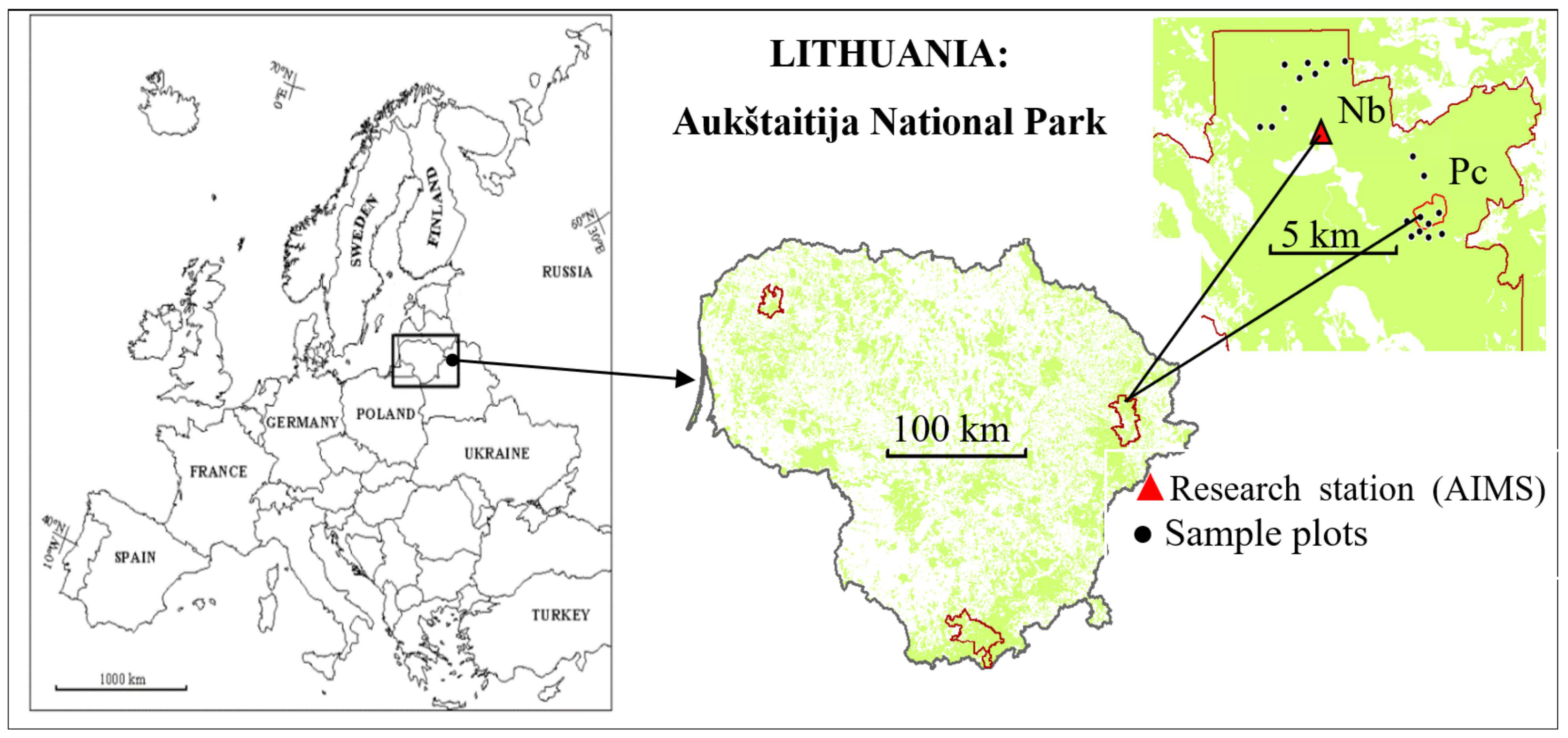

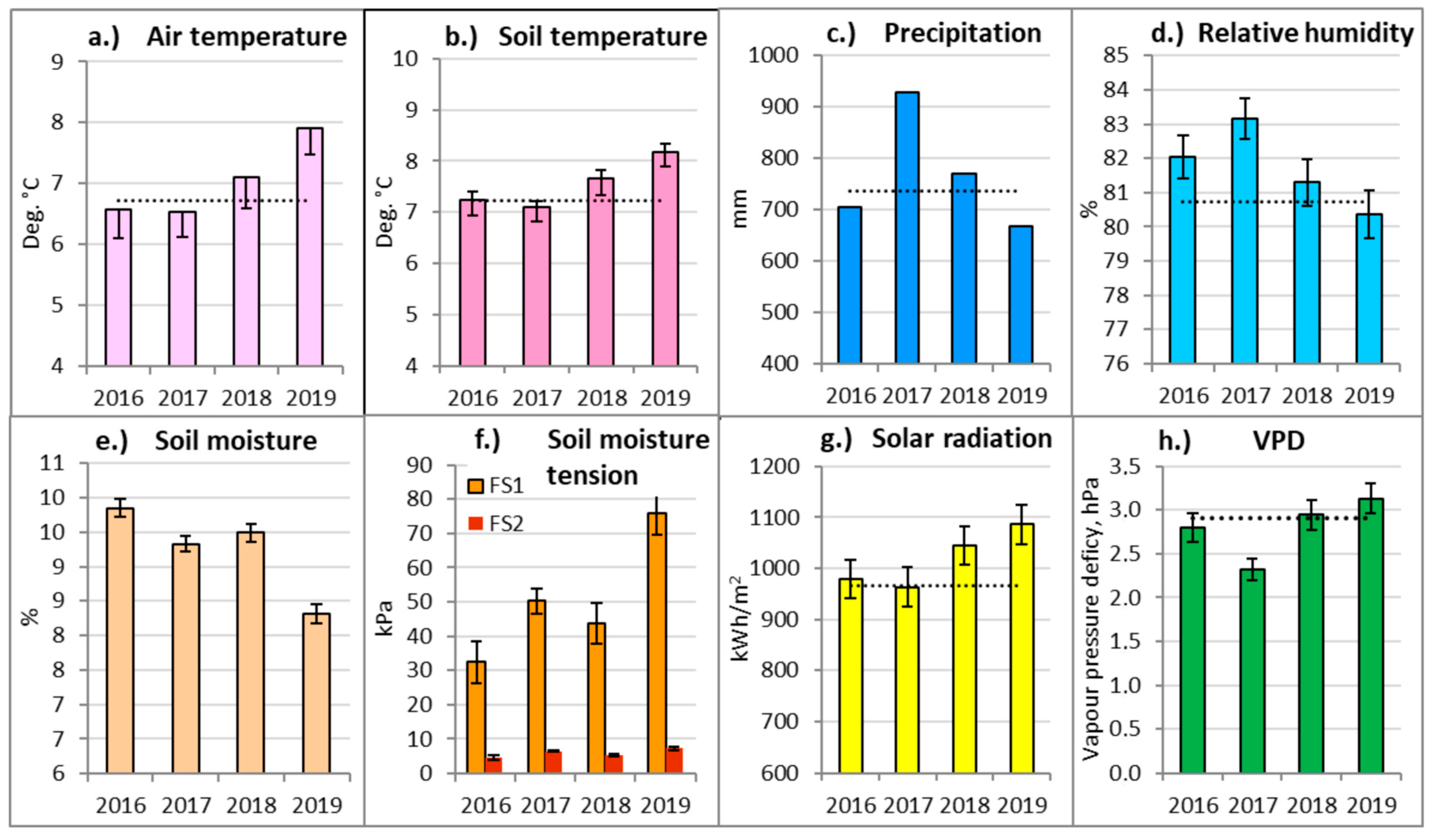

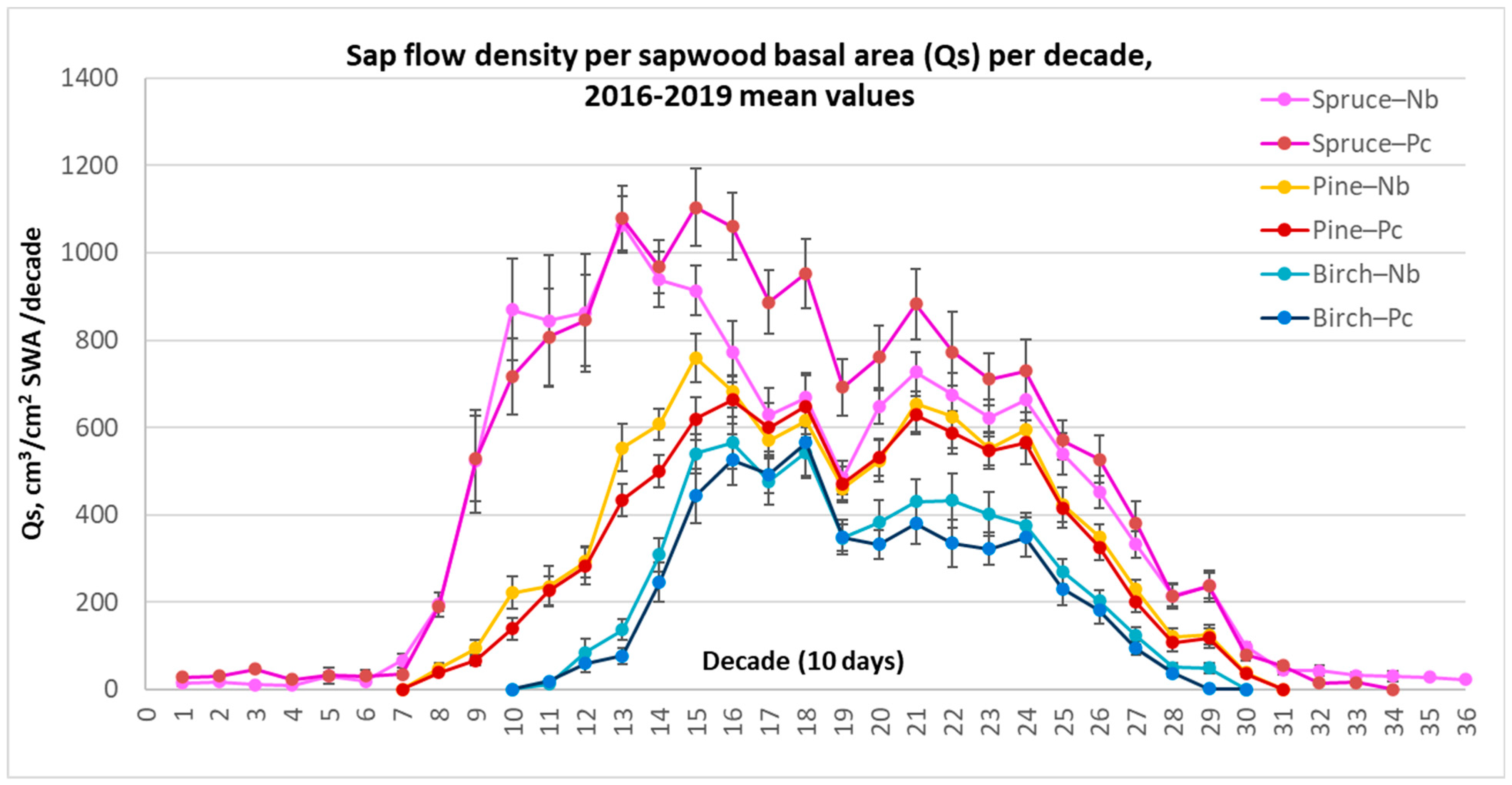
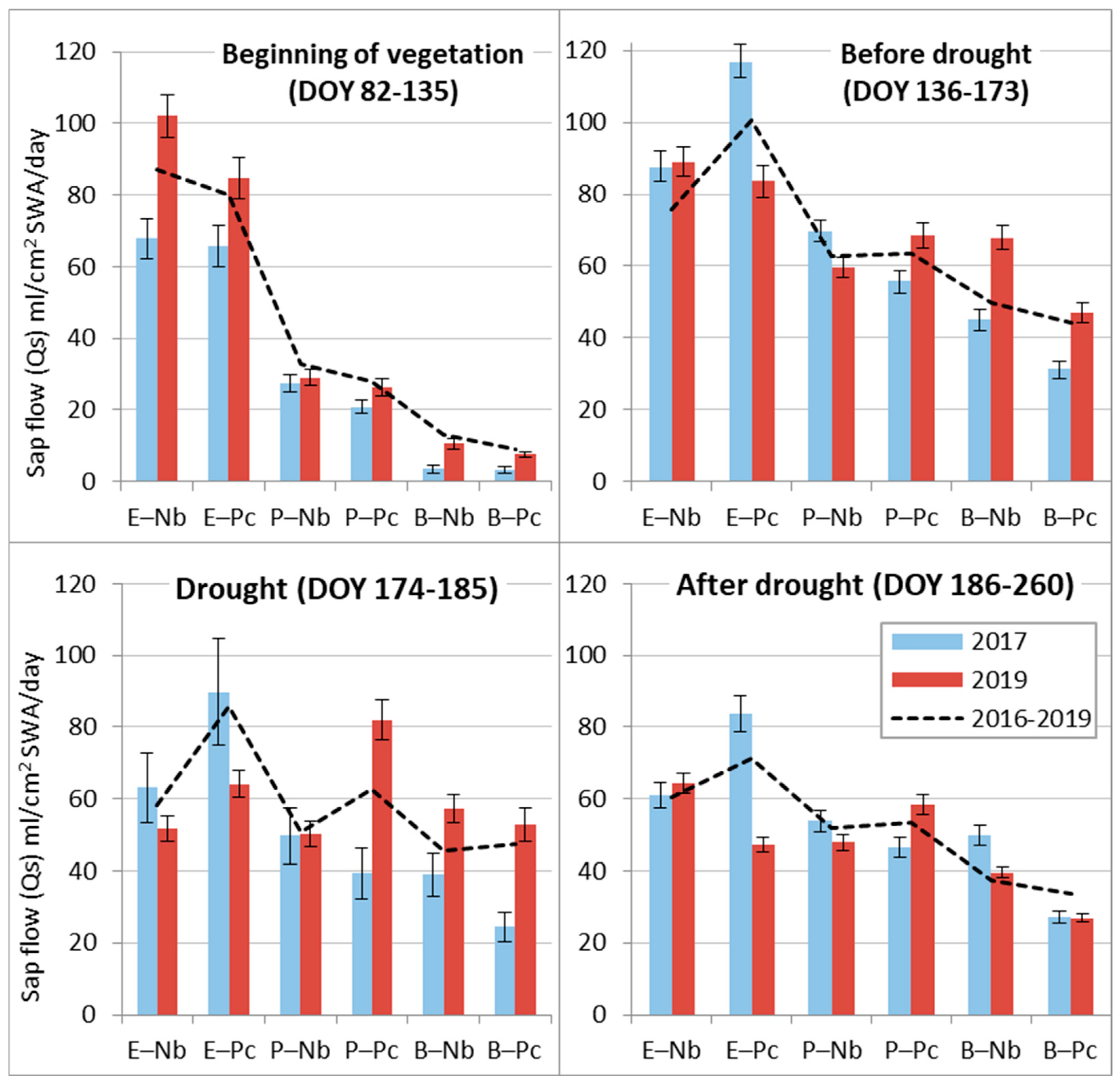

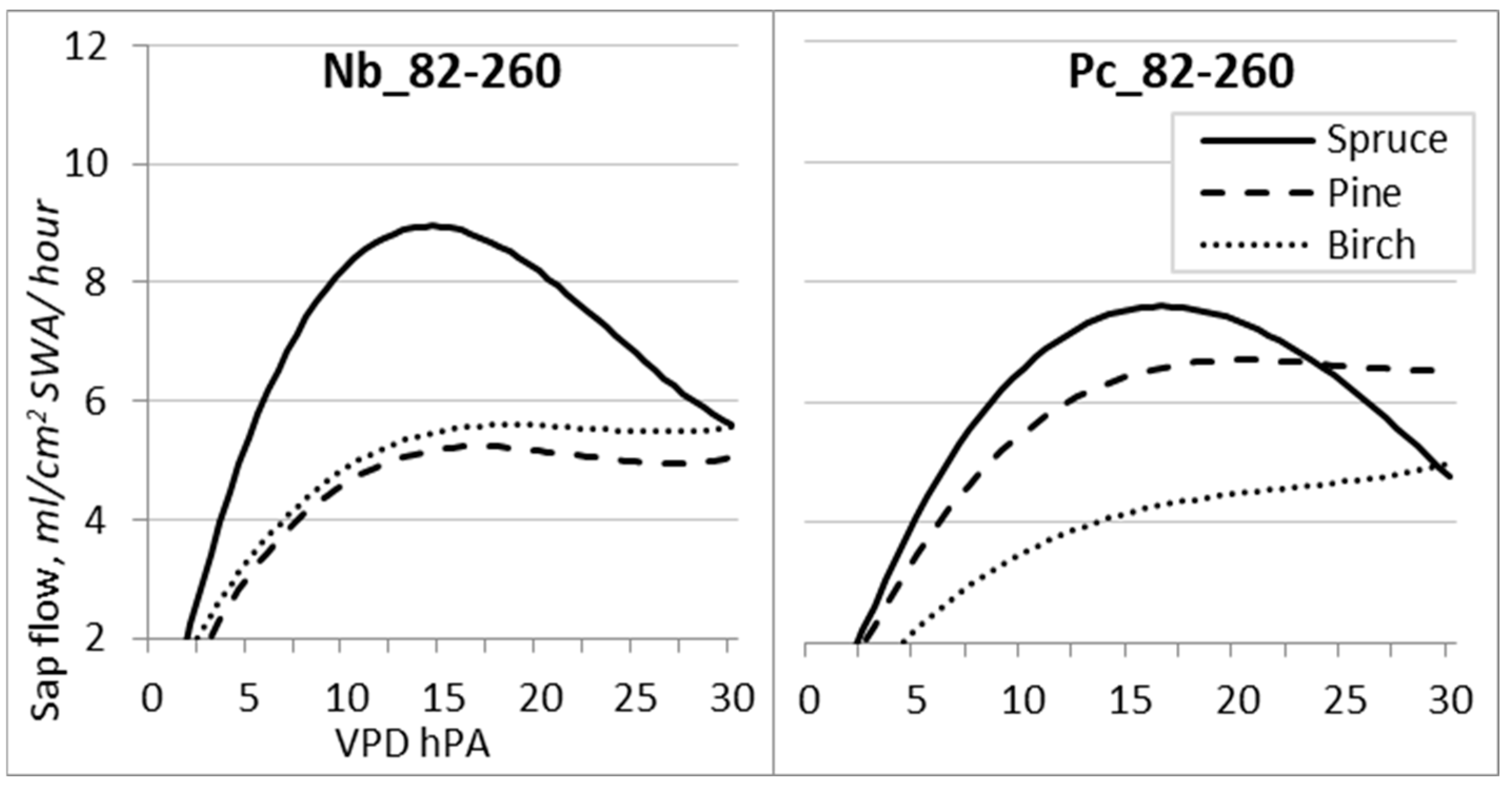

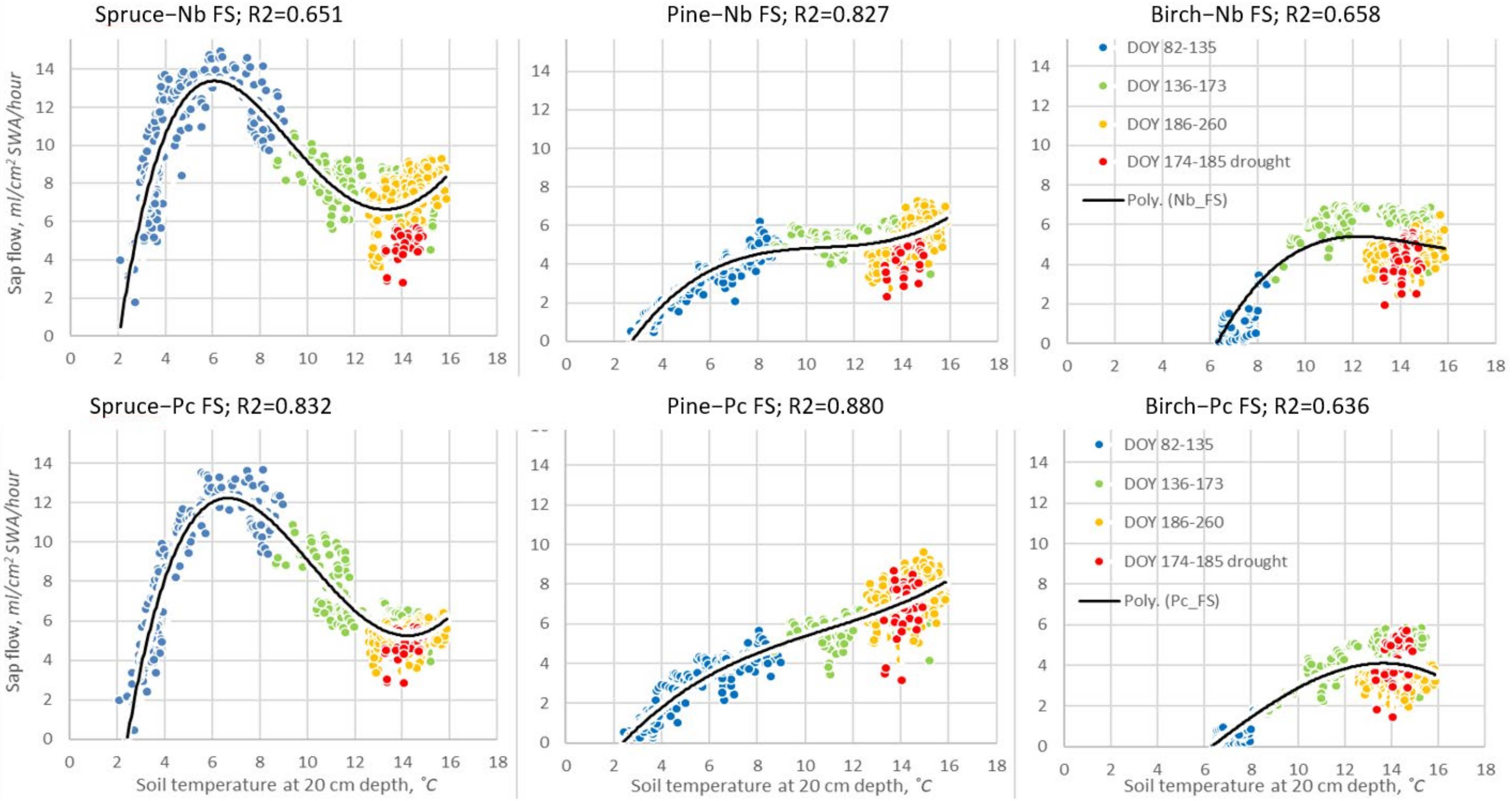
| Forest Sites | Nb | Pc | |||
|---|---|---|---|---|---|
| Soil Type | Sandy Normal-Humidity | Lowland Peatland Water-Saturated | |||
| Groundwater table depth, m | ≈3–6 | ≈0.5 | |||
| Rooting zone, cm | ≈80 | ≈40 | |||
| Soil horizon | AB | B1 | H1 | H2 | |
| Horizon depth, cm | 9–24 | 25–120 | 10–45 | 46–80 | |
| Wet bulk density, g cm3 | 1.51 | 1.61 | 0.865 | 1.03 | |
| Dry bulk density, g cm3 | 1.43 | 1.52 | 0.186 | 0.168 | |
| Free soil moisture, % | 21.6 | 20.7 | 368.8 | 521.8 | |
| Soil moisture, % | 5.6 | 5.73 | 100 | 100 | |
| Granulometric composition % | Sand (2000–63 µm) | 89.8 | 92.1 | ||
| Silt (63–2 µm) | 6.2 | 4.6 | |||
| Clay (<2 µm) | 4.0 | 3.3 | |||
| pHkcl | 4.4 | 4.9 | 6.7 | 6.7 | |
| Forest Site | Nb—Poor Normal-Humidity FS | Pc—Fertile Water-Saturated FS | ||||||
|---|---|---|---|---|---|---|---|---|
| Parameter | Diameter at 1.3 m | Height | Basal Area | Number | Diameter at 1.3 m | Height | Basal Area | Number |
| Units | cm | m | m2 ha−1 | Units ha−1 | cm | m | m2 ha−1 | Units ha−1 |
| Birch | 33.4 | 30.5 | 13.1 | 149 | 36.6 | 30.0 | 16.5 | 160 |
| Pine | 31.8 | 29.5 | 23.7 | 299 | 40.0 | 31.5 | 13.6 | 80 |
| Spruce | 29.8 | 29.0 | 3.5 | 50 | 43.5 | 32.0 | 11.5 | 241 |
| Total | 40.2 | 498 | 41.6 | 481 | ||||
| Forest Site | Species | Diameter DBH (cm) | Basal Area (cm2) | Height (m) | Tree Volume (m3) | Annual Increment Volume (dm3) | Bark Thickness (cm) | Sapwood Depth (cm) | Sapwood Area (cm2) | Tree Number (Unit) |
|---|---|---|---|---|---|---|---|---|---|---|
| Nb | Pine | 33.0 ± 3.6 | 864 ± 180 | 28.5 ± 2.1 | 1.06 ± 0.24 | 19.7 ± 3.1 | 2.1 ± 0.1 | 5.6 ± 0.4 | 421± 92 | 6 |
| Spruce | 26.6 ± 7.5 | 599 ± 370 | 22.7 ± 4.6 | 0.71 ± 0.52 | 23.2 ± 9.2 | 1.0 ± 0.0 | 3.6 ± 0.9 | 258 ± 160 | 5 | |
| Birch | 31.2 ± 6.2 | 794 ± 290 | 20.2 ± 6.2 | 1.00 ± 0.42 | 17.4 ± 6.9 | 2.4 ± 0.6 | 7.6 ± 1.4 | 464 ± 171 | 5 | |
| Pc | Pine | 39.1 ± 5.2 | 1220 ± 340 | 28.3 ± 2.4 | 1.50 ± 0.53 | 12.4 ± 4.8 | 2.4 ± 0.4 | 6.8 ± 0.9 | 596 ± 166 | 5 |
| Spruce | 40.4 ± 6.9 | 1320 ± 402 | 28.0 ± 2.4 | 1.74 ± 0.56 | 43.7 ± 19.8 | 1.0 ± 0.1 | 5.3 ± 0.8 | 568 ± 173 | 6 | |
| Birch | 36.7 ± 4.5 | 1071 ± 252 | 25.6 ± 1.8 | 1.34 ± 0.36 | 24.7 ± 17.2 | 2.3 ± 0.6 | 9.4 ± 1.2 | 680 ± 155 | 5 |
| Period, (DOY) | Air Temp., 2 m (°C) | Soil Temp., −0.2 m (°C) | Air Humidity, (%) | Soil Moisture, Nb (%) | Soil Moisture, Pc (%) | Soil Water Tension., Nb (Kpa) | Soil Water Tension., Pc (kPa) | Precipitation, (mm) | Solar Radiation, (w/m2) | Wind Speed, (m/s) | VPD |
|---|---|---|---|---|---|---|---|---|---|---|---|
| 2017 | 6.5 | 7.1 | 83.6 | 9.9 | 18.2 | 26.4 | 5.0 | 1019 | 108.1 | 1.6 | 2.3 |
| 82–260 | 12.1 | 10.4 | 77.2 | 9.3 | 17.0 | 34.0 | 5.2 | 578.1 | 182.8 | 1.4 | 3.8 |
| 82–135 | 5.0 | 4.5 | 72.3 | 10.7 | 18.2 | 13.2 | 5.4 | 114.0 | 163.4 | 1.5 | 3.1 |
| 136–173 | 14.3 | 10.8 | 70.3 | 7.8 | 15.3 | 52.1 | 5.7 | 67.1 | 245.0 | 1.4 | 5.8 |
| 174–185 | 15.0 | 12.8 | 83.5 | 10.8 | 19.5 | 36.7 | 4.3 | 120.7 | 169.2 | 1.7 | 3.0 |
| 186–260 | 15.7 | 14.1 | 83.3 | 8.9 | 17.1 | 38.9 | 4.9 | 276.3 | 167.5 | 1.4 | 3.6 |
| 2019 | 7.9 | 8.2 | 80.3 | 8.7 | 16.5 | 61.8 | 7.5 | 729 | 122.1 | 1.7 | 3.1 |
| 82–260 | 13.7 | 11.5 | 72.3 | 6.7 | 11.5 | 72.3 | 6.7 | 337.3 | 207.7 | 1.4 | 5.4 |
| 82–135 | 6.8 | 5.7 | 64.2 | 8.5 | 16.0 | 24.2 | 4.8 | 33.0 | 192.7 | 1.4 | 4.6 |
| 136–173 | 18.2 | 12.8 | 69.3 | 5.6 | 13.5 | 80.0 | 7.9 | 61.1 | 252.2 | 1.5 | 7.8 |
| 174–185 | 17.6 | 14.5 | 64.0 | 3.3 | 11.2 | 121.3 | 13.3 | 7.1 | 273.1 | 1.7 | 8.7 |
| 186–260 | 15.8 | 14.5 | 80.9 | 6.5 | 15.5 | 82.2 | 9.1 | 236.1 | 185.5 | 1.2 | 4.2 |
| Beginning (DOY) | End (DOY) | Duration (DOY) | |
|---|---|---|---|
| Spruce | 71.5 (69–74) | 323.6 (318–333) | 251.5 (249–259) |
| Pine | 74.1 (70–78) | 298.6 (296–303) | 224.5 (214–242) |
| Birche | 116.8 (105–123) | 281.9 (275–294) | 165.2 (153–176) |
| R2/ Period DOY | Spruce | Pine | Birch | n | |||
|---|---|---|---|---|---|---|---|
| Nb | Pc | Nb | Pc | Nb | Pc | ||
| 82–260 | 0.65 | 0.57 | 0.56 | 0.57 | 0.70 | 0.73 | 1074 |
| 82–135 | 0.93 | 0.88 | 0.46 | 0.56 | - | - | 324 |
| 136–173 | 0.79 | 0.52 | 0.86 | 0.79 | 0.84 | 0.66 | 228 |
| 174–185 | 0.61 | 0.80 | 0.68 | 0.71 | 0.59 | 0.77 | 72 |
| 186–260 | 0.90 | 0.93 | 0.76 | 0.87 | 0.74 | 0.83 | 450 |
Disclaimer/Publisher’s Note: The statements, opinions and data contained in all publications are solely those of the individual author(s) and contributor(s) and not of MDPI and/or the editor(s). MDPI and/or the editor(s) disclaim responsibility for any injury to people or property resulting from any ideas, methods, instructions or products referred to in the content. |
© 2024 by the authors. Licensee MDPI, Basel, Switzerland. This article is an open access article distributed under the terms and conditions of the Creative Commons Attribution (CC BY) license (https://creativecommons.org/licenses/by/4.0/).
Share and Cite
Augustaitis, A.; Pivoras, A. Sap Flow Density of the Prevailing Tree Species in a Hemiboreal Forest under Contrasting Meteorological and Growing Conditions. Forests 2024, 15, 1158. https://doi.org/10.3390/f15071158
Augustaitis A, Pivoras A. Sap Flow Density of the Prevailing Tree Species in a Hemiboreal Forest under Contrasting Meteorological and Growing Conditions. Forests. 2024; 15(7):1158. https://doi.org/10.3390/f15071158
Chicago/Turabian StyleAugustaitis, Algirdas, and Ainis Pivoras. 2024. "Sap Flow Density of the Prevailing Tree Species in a Hemiboreal Forest under Contrasting Meteorological and Growing Conditions" Forests 15, no. 7: 1158. https://doi.org/10.3390/f15071158




